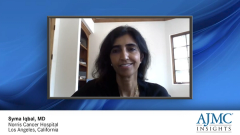
Defining Appropriate Response to Gastroesophageal Cancer Treatment
Expert panelists navigate optimal treatment strategies for patients with gastroesophageal cancer.
Episodes in this series

Laura Bobolts, PharmD, BCOP: Defining a response shouldn’t be overcomplicated. In the palliative setting, we’re trying to make sure the cancer hasn’t progressed. We’re hoping we can improve survival, progression-free survival, and response rate. But even if we get stable disease and the cancer isn’t progressing, that’s a win in the palliative setting. Because in the palliative setting, cancer wants to continue to grow. As long as we can slow it down, that’s a response to treatment per se. The ultimate response I’d love to see is overall survival. But at times, we have to take what we can get for our patients with cancer.
[As far as] when to switch therapies, if that cancer has progressed, then I’m saying, “What’s next?” If the cancer grew on that therapy, if I don’t have evidence-based medicine data that tell me that I can keep that therapy going beyond disease progression, and I’ll still get benefit for my patient, then it’s time to go to plan B. Now let’s think about what additional options do we have. What therapies has the patient’s body not seen? Then go to our second-line therapy. If the patient progresses, go to our third-line therapy, and so on. Switching of treatments more commonly comes when there’s disease progression, although it can come if the patient has unacceptable toxicity.
This is where pharmacists are key. Pharmacists in the oncology setting are vital in making sure that if a patient is having a symptom or toxicity, we can see if we can diagnose that toxicity and mitigate it as fast as possible. From a pharmacist’s perspective, whether it’s with drug treatment or another therapy, it’s very important that we manage toxicities up front and fast. The last thing we want to do is have our patients with cancer forgo a therapy that can improve their survival just because we let toxicity get out of control and it was unmanaged. I’m hoping that the majority of therapies are switched more or less from disease progression. Toxicity may be beyond our control, but with what we can control, we must do a good service for patients with cancer.
James M. Cleary, MD, PhD: What are the signs that you’re looking for to say that a patient has progressed on a therapy? When we were using only chemotherapy and targeted therapy, it was much simpler. When you saw that a scan was showing growth of existing cancerous lesions or new lesions, you knew the treatment wasn’t working and it was time to move on. Immunotherapy is a little more complicated. Not that often, but occasionally you can see what’s called pseudoprogression. That’s when you look at the first scan and the tumors look bigger, but it isn’t tumor growth. It’s just swelling. If you wait a little longer, you’ll start seeing tumor cell regression. With immunotherapy, when the patient’s symptoms aren’t getting worse and their performance status is good, I like to give it at least 12 weeks before I take someone off immunotherapy because you need that much time to see if the immunotherapy is working.
Transcript edited for clarity.
Newsletter
Stay ahead of policy, cost, and value—subscribe to AJMC for expert insights at the intersection of clinical care and health economics.










































